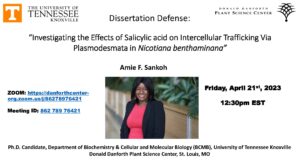Project summary: Plasmodesmata (PD) are plasma membrane-lined pores in plant cell walls that allow trafficking of small molecules and macromolecules, including metabolites, signaling molecules, and some hormones, from one plant cell to another. Interestingly, the plant hormone salicylic acid (SA) does not traffic via PD, but instead moves through the apoplast, but it can function to influence PD trafficking. Indeed, SA is a critical hormonal signal that regulates this cell-to-cell permeability in response to pathogen infection. Previous studies have shown SA to regulate plasmodesmata through regulation of callose, which can occlude PD and limit transport. SA has long been known to activate plant responses to pathogens by potentiating systemic acquired resistance (SAR). SAR is a secondary immune response that acts against pathogens in plants. Because PD are very important for plant growth, development, and defense, we seek to understand the molecular mechanisms involved in PD regulation and trafficking. This study focuses on investigating the cellular mechanisms of how SA could directly or indirectly regulate intercellular trafficking by adjusting PD permeability. Here, we present approaches to investigate how SA is connected to PD transport in epidermal leaf tissues of N. benthamiana. We seek to understand how SA regulates PD through callose accumulation or decumulation at PD in a time and concentration dependent manner. We addressed what callose dynamics are associated with SA-mediated changes to intercellular trafficking by investigating the correlation between callose deposition and PD movement using callose staining with aniline blue and an intercellular GFP transport assay. We also measured PD distribution in SA-treated tissue using a fluorescent PD marker and transmission electron microscopy (TEM).
Please use the link and meeting ID to access the defense.

